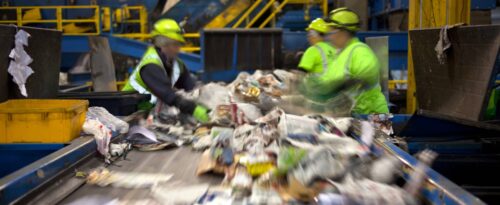
No Time to Waste: Mitigating Methane Emissions from Waste
Every day we discard our waste and — once it leaves our home or workplace — we think very little of it. Out of sight, out of mind. We often think of waste as a solved problem, particularly if we recycle and compost or live in developed countries where open dump sites are uncommon. However, solid waste presents a significant environmental threat hiding in plain sight: methane emissions.
A new report by RMI, Carbon Mapper, and IG3IS sheds light on rising methane emissions from the waste sector. The Key Strategies for Mitigating Methane Emissions from Municipal Solid Waste report highlights effective strategies to address this threat in the decisive decade of the 2020s.
The Municipal Solid Waste Methane Opportunity
Methane is a super potent greenhouse gas (GHG) responsible for roughly 30 percent of global warming since preindustrial times — and it has an outsize near-term warming impact compared with CO2. We will not achieve a 1.5°C future without addressing methane, but climate science suggests that we are moving in the wrong direction. Methane emissions have grown rapidly since 2007, and recently the National Oceanic and Atmospheric Administration reported record levels of atmospheric methane for the second year in a row.
Reducing methane emissions from the waste sector is a climate-critical but often overlooked strategy. Today, the waste sector contributes almost 20 percent of global human-caused methane emissions and is the single largest source after oil and gas and enteric fermentation (i.e., livestock digestion process). Municipal solid waste (MSW) — trash or garbage we throw out every day — is responsible for the majority of waste sector methane emissions, and the problem is growing. The world currently generates 2 billion metric tons of MSW each year, and this volume is expected to increase by 70 percent by 2050 (due to increased urbanization and population growth), driving a proportionate increase in methane emissions from landfill gas (LFG).
Fortunately, it is technically feasible to reduce methane emissions from landfills and dump sites by 80 percent — and we must act now.
Where Does MSW Methane Come From?
The methane impact of MSW depends on its composition, how it is disposed of, where it goes, how it is managed, and meteorological conditions, among other factors — which can vary geographically. In developed countries, waste is increasingly sent to materials recovery facilities (MRF) or mechanical biological treatment (MBT) plants, where recyclables and organic waste can be recovered and sold for profit or processed into beneficial end products or commodities. The residual waste is then sent to landfills. In developing countries, where these recovery and treatment facilities are less common, the waste is often sent directly to a landfill or dump site, with limited recovery and treatment of organics and recyclables.
When organic materials like food waste, yard waste, paper and cardboard, or other decomposable waste are not recovered but instead placed in landfills and dump sites, they decompose under anaerobic conditions and produce LFG, which primarily comprises carbon dioxide and methane. Unless captured, the LFG escapes into the atmosphere, where it contributes to global warming.

Gardener removing food waste from the top of a composting bin pile, before spreading the compost onto a garden
Key Strategies for Reducing MSW Methane Emissions
When determining which actions can effectively mitigate MSW methane emissions, we must consider methane sources across the entire value chain. The report presents strategies that have proven effective in helping the MSW industry realize concrete reductions in methane emissions (as shown in the figure below), highlighting best-in-class case studies and areas for priority action over the coming decade. It goes further to describe design and operational improvements that can be implemented at the landfill and how comprehensive monitoring can be leveraged as an essential tool to mitigate methane emissions.
Optimizing Landfill Design and Operation for Methane Mitigation
While it is preferable to divert organic waste to prevent it from reaching land disposal sites in the first place, organics diversion is unlikely to prevent all decomposable waste from reaching landfills and dump sites. Therefore, the report emphasizes practices for designing and operating landfills across all stages of their life cycle — from the earliest design stages to ongoing operations and maintenance — to optimize methane abatement. These strategies specifically address methane emissions from previously landfilled and future nondiverted organic waste. These measures should serve as a toolbox for landfill owners and operators as well as design experts, guiding the development of a comprehensive methane abatement strategy at individual landfills, where the optimal suite of technology solutions vary.
Making the Invisible Visible
One reason MSW methane emissions have flown under the public radar is the fact that they have been difficult to pinpoint and quantify. But today, advanced satellite and airborne remote sensing technologies are providing improved quantification and visualization of methane from solid waste facilities. These monitoring technologies have expanded evidence for some facilities generating much higher methane emissions than predicted by landfill models due to highly variable management practices. Advances in waste site methane monitoring can contribute to more accurate GHG inventories and make more of these emissions visible and therefore actionable by operators.
Changing the Trajectory of Rapidly Accelerating Methane Emissions
While some leading operators are capitalizing on the opportunities to reduce methane, waste is an environmental problem that has not been completely solved. There is more to be done, and quickly. Understanding, monitoring, and managing methane emissions from the waste sector presents a near-term opportunity to mitigate and change the trajectory of global warming — and it is an opportunity we cannot afford to overlook any longer.